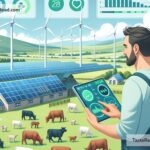The Future of Sustainable Grain Production: A Path Forward for Feeding the World
Grains like wheat, rice, and corn are the backbone of global diets. They provide the calories and nutrients billions of people need to survive. But growing these grains sustainably is becoming a bigger challenge. Climate change, soil degradation, water shortages, and population growth are putting pressure on farmers, land, and natural resources. To meet the needs of future generations without harming the planet, we need innovative solutions for grain production that are environmentally friendly, socially responsible, and economically viable.
In this blog, we’ll explore the challenges faced by grain producers and discuss how technology, smarter farming practices, and international collaboration can pave the way for a sustainable future.
Why Grain Production Needs to Be Sustainable
First, let’s talk about why sustainability matters in farming. Today, farming uses up vast amounts of our planet’s resources. Growing grains requires fertile soil, water, energy, and space. Over time, over-farming can harm the environment. For example:
- Soil Degradation: Planting the same crops over and over can strip nutrients from the soil, reducing its fertility and ability to grow healthy food.
- Water Use: Agriculture uses about 70% of the world’s freshwater supply. Grain production is water-intensive, and water shortages are becoming more common in many parts of the world.
- Carbon Emissions: Many farming practices release greenhouse gases like carbon dioxide and methane into the atmosphere, contributing to climate change.
- Biodiversity Loss: Large-scale monocropping—the practice of growing only one type of crop—can reduce plant and animal biodiversity, harming ecosystems.
At the same time, the global population is expected to grow to nearly 10 billion people by 2050. That means farmers will need to produce more grain than ever, but in a way that protects the environment and supports long-term well-being for the planet and its people.
The Role of Technology
Technology is one of the key tools for making grain production more sustainable. Here are some exciting advancements that farmers and scientists are working on:
-
Precision Farming: Precision farming uses advanced technologies like GPS, sensors, and data analytics to help farmers grow crops more efficiently. For example, instead of watering entire fields, farmers can target irrigation to areas that need it most, saving water. Sensors can also measure soil nutrients so farmers use fertilizers more sparingly, reducing pollution.
-
Drought-Resistant and Climate-Smart Crops: Scientists are developing grains like wheat and rice that can survive tough conditions, like droughts, heatwaves, or flooding. These climate-smart crops make it possible to grow food even in areas affected by extreme weather.
-
Vertical Farming and Hydroponics: Traditional farming relies on land, but vertical farming and hydroponics allow grains and other crops to be grown in stacked layers or water-based systems. These techniques use less water and space and can be set up in urban areas where farmland is scarce.
-
AI and Machine Learning: Farmers are now using artificial intelligence (AI) and machine learning to analyze weather patterns, predict crop yields, and identify threats like pests or diseases early. With this data, they can respond quickly and prevent crop losses.
Smarter Farming Practices
Technology is helpful, but sustainable farming also requires smarter practices that work in harmony with nature. For example:
-
Crop Rotation: Instead of planting the same crop year after year, farmers can rotate different crops to keep soil healthy and reduce the need for chemical fertilizers.
-
Conservation Tillage: In traditional farming, the soil is heavily tilled (plowed), which can lead to erosion and carbon loss. Conservation tillage minimizes disturbance to the soil, preserving its structure and nutrients.
-
Integrated Pest Management (IPM): Instead of using chemical pesticides, farmers can manage pests with natural methods, such as introducing beneficial insects, planting pest-repellent crops, or using biological controls.
-
Polyculture Farming: Polyculture involves planting more than one type of crop in the same field. This increases biodiversity, protects soil health, and makes farming more resilient to extreme weather.
Global and Local Collaboration
Sustainability isn’t just about technology or farming techniques—it’s also about teamwork. Governments, communities, and organizations must work together to create policies and practices that support sustainable farming.
-
Education and Training: Farmers need access to information, training, and resources to successfully adopt sustainable practices and technology.
-
Fair Trade and Support for Small Farmers: Small-scale farmers grow much of the world’s food but often lack funding. Supporting them with fair trade policies, subsidies, and investment can help them transition to sustainable methods.
-
International Cooperation: Climate change and environmental problems don’t respect borders. Countries need to work together to share research, technology, and solutions for sustainable agriculture.
A Bright Future for Sustainable Grains
While the challenges of sustainable grain production are significant, the solutions are within reach. Advances in technology, innovative farming strategies, and global partnerships can help us produce enough food for everyone while protecting the planet. It will take hard work, smart investments, and commitment, but the future of grain farming can be both abundant and sustainable.
By supporting farmers, investing in research, and embracing eco-friendly methods, we can sow the seeds for a healthier planet and a brighter future. After all, grains aren’t just food—they’re a foundation for life. Let’s make sure we keep growing them in a way that benefits both people and the planet.
Sustainability is a journey, not a destination. With the right choices and efforts, we can ensure that generations to come will have the food they need and a thriving planet to call home.

